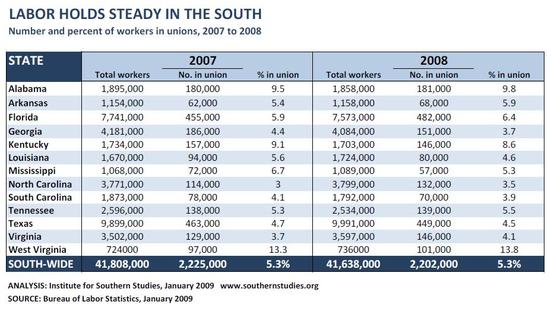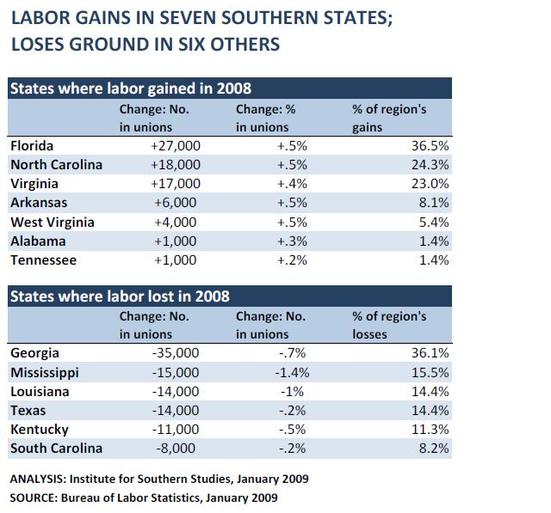Report: Southern unions hold steady amidst economic turmoil
 Union membership in Southern states held steady in 2008 amidst rising unemployment and a troubled economy, according to an analysis of government statistics released this week.
Union membership in Southern states held steady in 2008 amidst rising unemployment and a troubled economy, according to an analysis of government statistics released this week.
A review of new Bureau of Labor Statistics data by the non-profit Institute for Southern Studies finds that the percentage of workers in the South belonging to unions in 2008 stayed at 5.3 percent, the same unionization rate as in 2007.
Among the 13 Southern states included in the Institute analysis, seven showed union gains and six had a net loss in union membership. Nationally, union membership rose from 12.1 percent of employees in 2007 to 12.4 percent in 2008, the second year in a row that unions had shown gains.
 Southern unions were able to hold their ground despite big job losses in the region. The total number of union members in the South actually declined by 23,000 in 2008, but because the overall Southern workforce shrank even more, the rate of unionized workers stayed the same.
Southern unions were able to hold their ground despite big job losses in the region. The total number of union members in the South actually declined by 23,000 in 2008, but because the overall Southern workforce shrank even more, the rate of unionized workers stayed the same.
"Southern union members appear to have weathered the economic downturn slightly better than their non-union counterparts, for a number of reasons," said Chris Kromm, director of the non-profit Institute. Likely factors include the kind of industries that have lost jobs, like the largely non-unionized finance sector, and greater job protections enjoyed by union members, Kromm said.
Among other findings of the Institute for Southern Studies analysis of federal labor data:
- Southern states remain the least unionized in the nation: Of the 12 states nationally with 6 percent or less of their employees in unions, nine were in the South. North Carolina had the lowest rate of unionization, with just 3.5 percent of its workers belonging to a union.
- Florida, North Carolina and Virginia had the biggest gains in union membership: Florida led the South by adding 27,000 union members in 2008. North Carolina was second with union membership growing by 18,000, including a major election victory in December by the United Food and Commercial Workers at pork processing giant Smithfield Foods.
- Georgia, Mississippi, Louisiana and Texas saw the biggest union losses: Georgia alone lost 35,000 union members in 2008, over a third of labor's total losses in the South. Union membership also declined by at least 14,000 in Mississippi, Louisiana and Texas.
The Bureau's 2008 Union Members Survey contained other data of special interest to Southern states:
- Union Membership by Race: Black workers were more likely to be union members (14.5 percent) than workers who were white (12.2 percent), Asian (10.6 percent), or Hispanic (10.6 percent). Over 40% of African-Americans nationally live in the 13 Southern states included in the Institute's analysis.
- Union Membership by Sector: Government jobs continue to be important to union membership. The union membership rate for public sector workers (36.8 percent) was substantially higher than the rate for private industry workers (7.6 percent). Within the public sector, local government workers - including teachers, police officers and fire fighters - had the highest union membership rate, 42.2 percent. In North Carolina and Virginia, unions are mounting campaigns to overturn bans on collective bargaining in public sector jobs.
- Union Representation of Non-Members: About 1.7 million wage and salary workers were represented by a union on their main job in 2008, while not being union members themselves. All Southern states except Kentucky and West Virginia have "right to work" laws which enable employees to benefit from union contracts without having to join a union.
Tags
Chris Kromm
Chris Kromm is executive director of the Institute for Southern Studies and publisher of the Institute's online magazine, Facing South.

